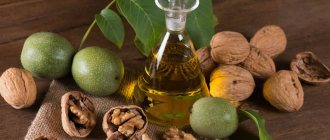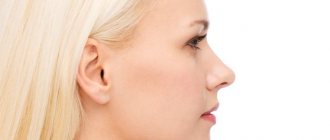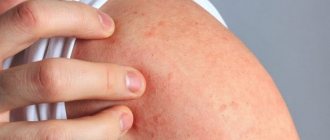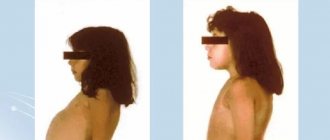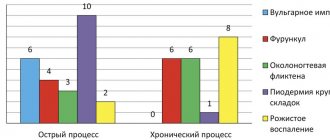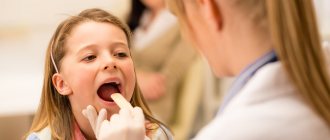Atopic dermatitis is a chronic skin disease. Due to disruption of biochemical processes, excessive dryness, peeling, redness occurs, inflammatory processes develop, and itching is felt. It develops under the influence of allergens, and is often combined with bronchial asthma, food allergies, and allergic rhinitis. It appears in the first years of life, most often before 12 months or at the age of 2-3 years, when the children's diet expands and many allergenic foods enter it. With proper treatment and care, the disease enters the stage of stable, long-term remission, but can manifest itself in adolescents, young and elderly people during contact with allergens, a weakened immune system, and after stress.
Symptoms
With atopic dermatitis in children, skin tightness, redness appears, the skin flakes, feels rougher to the touch, and thickening may appear. Microscopic bubbles form, around which moisture is released. The child is worried and scratches the affected areas. When an infection occurs, local inflammation develops and the wounds heal poorly. With significant spread in young children, general intoxication of the body manifests itself: the temperature rises, the peripheral lymph nodes enlarge. Due to severe itching, sleep and appetite are disrupted, and the child often cries. Dermatitis most often affects the face, neck, armpits, scalp, groin, areas under the earlobes, popliteal fossae, and elbows.
Medicine knows about 2,000 different skin diseases, which are united by a common medical term - dermatoses.
Among them, psoriasis and atopic dermatitis are the most common. The head of the clinic of dermatovenerology and allergology-immunology of the European Medical Center, candidate of medical sciences, doctor of the highest category Eva Pechatnikova and you understand these common skin diseases and find out the most effective treatment methods phototherapy of the European Medical Center Dmitry Serov.
Atopic dermatitis and psoriasis: more similarities or differences?
Despite the fact that psoriasis and atopic dermatitis belong to the same group of diseases (dermatosis), they are completely different skin problems. Atopic dermatitis belongs to a group of allergic diseases, usually hereditary. Polypous rhinosinusitis, bronchial asthma, hay fever (pollen allergy) are all diseases similar to atopic dermatitis. Psoriasis has a completely different pathogenesis, which often causes inflammatory processes in the joints, kidneys and other organs and tissues. Thus, these skin problems have different clinical presentations. Moreover, they can be combined, that is, one patient can have both atopic dermatitis and psoriasis.
The only thing that is similar between these diseases is the prominent role of cytokines.
Cytokines are pro-inflammatory proteins that are secreted by immune cells (T-lymphocytes, B-lymphocytes, monocytes, macrophages, etc.). There are several groups of these protein formations, but the common property of all cytokines is their influence on immune cells, stimulating their development and transmitting information from cell to cell. In other words, cytokines are regulators of the body's immune responses. In the event of a violation of coordination of actions between immune cells, cytokines provoke processes that intensify rashes in both atopic dermatitis and psoriasis.
How do atopic dermatitis and psoriasis manifest?
Psoriasis affects about 3-7% of the world's population. This disease has no age limit, but is most often diagnosed in patients 29-36 years old. Typically, psoriasis appears as pink, scaly patches on the elbows and knees and on the scalp. Sometimes defects appear on the nails. In advanced forms of the disease, the entire body may be covered in pink, itchy plaques.
The main manifestations of atopic dermatitis (or neurodermatitis) are skin rashes, most often in areas of large folds, face and neck. The main distinguishing symptom of this disease is itching. As a rule, neurodermatitis manifests itself in childhood, and then becomes chronic and accompanies a person throughout his life.
How dangerous are these diseases?
If dermatosis is not detected in time, it often leads to complications. Advanced forms of psoriasis are dangerous for the development of psoriatic arthritis, that is, damage to the joints. In this case, complex treatment requires the help of not only a dermatologist, but also a rheumatologist.
Exacerbation of atopic dermatitis provokes inflammation of the lymph nodes (in the cervical, axillary, inguinal, femoral areas), ophthalmological abnormalities (recurrent conjunctivitis and ectropion, that is, eversion of the eyelid). In addition, there is confirmed medical evidence that patients with atopic dermatitis are more likely to suffer from herpes simplex virus and HPV. Often, bacterial and fungal infections develop in parallel with atopic dermatitis.
Causes of psoriasis and atopic dermatitis
The main and proven cause of both atopic dermatitis and psoriasis is genetic predisposition. For example, if one of the parents is a carrier of atopic dermatitis, then with a 50% chance the disease will be passed on to the child. If the carrier is the mother, then this probability increases.
Regarding psoriasis, we can say that this skin disease is not fungal, that is, it cannot be infected through household contact. Psoriasis can develop under the influence of stress, infectious diseases and trauma.
How is the disease diagnosed?
There are a number of tests that are always performed when you first visit your doctor. If necessary, the diagnosis is established using histological examination. But in most cases, a general clinical picture is enough to make a conclusion.
Traditional and modern treatments
When treating skin diseases, the doctor is guided by the rule of the so-called therapeutic ladder. The specialist begins by prescribing the simplest treatment methods. If such practices are ineffective, the doctor moves to the next stage of treatment, where systemic and biological therapy drugs can be used. Thus, the first stage is standard methods, the second is physiotherapeutic techniques, the third is systemic, and then biological therapy.
Laser therapy, ultrasound, magnetic therapy, and phototherapy are used as physiotherapeutic treatments. This type of treatment is very effective. However, it is worth noting that physiotherapy is not used in the acute phase of skin diseases. During periods of severe inflammation, treatment procedures can aggravate the situation and provoke the appearance of new lesions.
One of the ways to alleviate the manifestations of psoriasis is plasmapheresis - a procedure for cleansing the blood of toxins, poisons, salts and other harmful substances. It is important for people with psoriasis to watch their diet, eat a low-calorie diet, and avoid fried foods and alcohol. Psychotherapeutic sessions with a specialist are also a necessary element of treatment. The specialist helps the patient understand what disturbances in the psycho-emotional state could cause psoriasis, and in the future they work together on the optimal ways to respond to the triggers.
Of course, drug therapy is also used to treat skin diseases. Often, patient treatment is supplemented by the prescription of antihistamines, antibacterial, antiviral, and antimycotic agents. To restore damaged skin, emollients and moisturizers with a predominance of ceramides, lipid components of the cell membrane, are used. For mild cases of the disease, doctors recommend taking calcineurin inhibitors, that is, non-steroidal immunomodulators. In case of severe manifestations of atopic dermatitis, cyclosporine is prescribed. This remedy is very effective, but it cannot be abused over a long period of time (more than 1-2 years). This is due to the toxicity of some substances included in its composition.
To maintain a state of remission in patients, experts recommend, first of all, special skin care. To do this, every time after taking a shower, it is necessary to apply emollients to the skin - products whose composition is completely identical to the composition of the lipid mantle of our skin.
The above methods are used to treat both psoriasis and atopic dermatitis. The specific method of therapy for each patient is selected by the doctor based on the overall clinical picture. It is worth noting that in the treatment process, an important point is close interaction between doctors: dermatologists, allergists, rheumatologists. It is teamwork that allows us to achieve guaranteed positive results from the therapy.
Biological therapy - a revolution in the treatment of atopic dermatitis and psoriasis
Biological therapy completely changes the paradigm of treatment of skin diseases and helps to achieve sustainable remission.
The essence of this modern therapy is that it affects cytokines, that is, information molecules that cause the development of psoriasis and atopic dermatitis. It is biological drugs that make it possible to “freeze” the development of the disease. Previously, such medicines could only be found abroad, but now they are available in Russia.
A few years ago, getting rid of 50% of all skin rashes was considered an excellent result. Now, with the help of biological therapy, doctors are able to clear the patient’s skin almost 100%. At the moment, there is no type of psoriasis and atopic dermatitis for specialists that they cannot cope with.
As a result of treatment, the patient forgets about the existence of his illness. Unlike other types of systemic therapy, drugs consisting of large protein molecules do not have harmful effects on internal organs. Therefore, they can be appointed on a permanent basis.
The principle of action of biological drugs can be illustrated by the example of dupilumab, a drug based on monoclonal antibodies. This biological drug blocks inflammatory processes caused by cytokines. Thus, treatment with dupiluamab reduces the concentration of biomarkers in the blood that provoke a severe course of the skin disease. Such biological therapy is effective due to its selectivity and helps where all other methods have failed. Contraindications to the use of drugs obtained by innovative genetic engineering methods depend on the patient’s individual tolerance to certain substances.
Quality of life of patients after treatment
Even with severe forms of psoriasis and atopic dermatitis, doctors restore quality of life to patients. Those who could not attend work due to joint disease and significant skin damage can now live an absolutely normal life, have a family, children, etc. Some patients could not leave the house, were forced to leave work, fell into deep depression, and did not see any prospects for a complete cure. And it was biological therapy that was able to help them start a new life without discomfort.
Prevention
Atopy is translated from Latin as strangeness. The causes of the disease cannot always be determined. But long-term observation of patients and members of their families has revealed that it develops more often:
- with a genetic predisposition - if the parents are healthy, the probability of developing dermatitis in the child is 20%, if one of them is sick - 50%, if both are sick - 80%;
- in case of unfavorable pregnancy, active or passive smoking of the expectant mother, consumption of food that provokes allergy attacks, use of certain medications;
- when a newborn is in a dusty room, insufficient care for his personal hygiene;
- with prolonged exposure to allergens that enter the child’s body with food through the respiratory tract.
Breastfeeding for up to 6 months and avoiding allergy-provoking foods reduces the likelihood of developing atopic dermatitis.
Contact dermatitis - symptoms and treatment
Symptoms of simple contact dermatitis:
- soreness;
- redness;
- burning;
- edema;
- itching (less pronounced).
Sometimes blisters with clear serous fluid appear, which can burst. As a result, weeping occurs in the area of dermatitis - fluid separation. If an infection is added to the irritation, pustules appear.
Symptoms of allergic contact dermatitis:
- severe itching;
- edema;
- redness;
- blisters with serous fluid, which then dry out and form scales and crusts;
- pain as a result of scratching and secondary infection.
When dermatitis becomes chronic, peeling and thickening of the skin may occur in areas of inflammation [3]. If the patient does not begin treatment in a timely manner, the disease progresses, and allergens appear - rashes on other parts of the body, far from the primary focus.
Dermatitis can affect various areas of the body: scalp, face, eyelids, mouth, lips, neck, hands, feet, limbs.
Scalp
On the scalp, dermatitis develops with increased sensitivity to certain metals, in particular nickel. Products made from it (for example, curlers, hair straighteners) can cause redness and itching. Hair washing products can lead to the development of “washing dermatitis”, which appears as strip-like lesions on the face and neck. Other causes of dermatitis are accessories with rubber or leather parts: hat band, cap lining, wig patch [5].
Face
Dermatitis can be caused by the use of cosmetics: moisturizers and sunscreens, hair care products, perfumes. Mobile phone use can cause dermatitis in the form of a unilateral rash on the cheek [6][7].
Eyelids
Sensitivity of the skin in the eyelid area often causes the appearance of dermatitis in this area. Dermatitis can be caused by the prescription of eye drops and the use of objects containing rubber, such as swimming goggles and microscope eyepieces. [8]. If you rub your eyes with your hands, “accidental” allergens can get on your eyelids.
Mouth, lips
The causes of damage to the oral cavity are dentures, crowns, and hygiene products. Nickel, cobalt, mercury, and gold are used to make dentures. These substances can cause burning and tingling sensations in the mouth [8][9]. An allergic reaction occurs to chemicals, flavorings contained in toothpastes and other oral care products. Sodium lauryl sulfate, which is part of toothpastes, often causes irritation.
Lip dermatitis is associated with the application of lipstick, which contains dyes, flavors, and preservatives. Another cause of lip dermatitis is the habit of putting metal objects in the mouth, in particular pens and pencils. Chronic dermatitis in the form of a plaque on the lower lip can develop in musicians who play wind instruments.
Neck
The use of cologne and perfume leads to rashes on the front surface of the neck. Photoallergic dermatitis of the face and neck can be caused by sunscreen agents. A rash in the form of a strip around the neck appears from contact with the collar of a shirt or coat if the allergen is part of paints and resins. Allergic dermatitis develops from contact with metal, which is part of jewelry - chains, necklaces. The lesion will correspond to the location of the decoration [13][14].
Hands, feet, limbs
Dermatitis can develop through daily contact with water, detergents, and the use of rubber gloves. There is palmar grip dermatitis, which affects the central part of the palm in contact with the allergen. The causes of such dermatitis are a mobile phone, a gear shift in a car, gripping a cane and other objects [2].
Hairdressers experience rashes due to the use of shampoos, hair dyes, and nickel-plated scissors [15]. If the periungual ridges on the fingers become inflamed, exposure to formaldehyde resin or acrylate in nail polish and artificial nails can be suspected.
Typical allergens that cause foot dermatitis are rubber vulcanizers in rubber, tanning agents, rosin, chromates, such as potassium biochromate in leather [16][17].
The upper and lower extremities are exposed to irritants and allergens [2]. Dermatitis is localized on the wrists, thighs, and calf muscles.
Torso
Dermatitis of the trunk is common, but it is not always possible to determine the source of the allergens. Rash on the abdomen and back occurs when wearing belts with buckles and bras with clasps containing nickel. Nickel can cause dermatitis on the left side of the chest if a man carries a lighter or other item containing this metal in his chest pocket.
In the armpits, dermatitis appears when using deodorants that contain fragrances, essential oils, propylene glycol, and parabens.
Clothing can be a source of allergens. Rashes occur during intense sweating and are located in areas of friction between the skin and clothing. The causes of contact dermatitis are both the fabric itself and the dyes used in its production [20]. In recent years, it has been associated with dimethyl fumarate. The substance is used as a biocide to prevent the growth of mold and is found in fabrics covering sofas [21]. This type of dermatitis is severe and affects the back, buttocks, and lower limbs.
What to feed a child with atopic dermatitis
In order not to provoke an exacerbation of dermatitis, to relieve itching and redness of the skin, you need to follow a diet. Foods that burden the immune system are excluded from the children's diet: citrus fruits, chocolate, eggs, honey, seafood. Red (strawberries, cherries, currants, apples) and exotic (mangoes, coconuts, pineapples) fruits are dangerous.
Split meals are recommended: small portions every 3-4 hours. It is better to boil, stew, bake, but not fry. Do not use spices, black pepper. The diet should be balanced and contain enough protein, vitamins, and microelements.
Avoid giving your child sugary carbonated drinks, chips, crackers and other snacks for as long as possible. If the infant is receiving breast milk, introduce new foods carefully. Add the product once a week to make sure it doesn't cause breakouts. After meals and between meals, offer your baby clean boiled water.
Skin care
To relieve itching and prevent infection of the affected skin, you need to properly care for your skin:
- It’s better not to take a shower, but to take a cool bath for about 10 minutes; use medicated bathing products with a soft base that cleanse but do not dry the skin;
- moisturizing and softening – the skin should not be dry to prevent flaking and cracking; regularly apply a moisturizer recommended by a dermatologist;
- Do not let your child scratch the affected areas to avoid infection - apply anti-itching products to the atopic areas.
Cream or gel relieves discomfort during an exacerbation and allows you to sleep, eat, and play peacefully. Apply the drug to cleansed skin, treat atopic lesions and the areas around them. Do not exceed the recommended dosage and frequency of use.
Treatment of atopic dermatitis in children
In this article, we will pay great attention to the treatment of this disease, and will also talk about the main features of the use of medications in children with atopic dermatitis.
The basis of treatment is external therapy using various medications. The goal of external (local) therapy is the complete elimination of inflammatory changes, itching, as well as restoration of the water-lipid layer of the skin. Local glucocorticosteroids (hormones), calcineurin inhibitors, and emollients are used as such agents. We will pay special attention to emollients. Emollients are medicinal cosmetics that care for the skin and prevent dry skin. In some cases, systemic therapy is also prescribed. Systemic therapy refers to the use of drugs that are administered orally. Antihistamines are most often used as systemic therapy.
Below we consider the most common drugs for the treatment of blood pressure in children.
The goal of local therapy for atopic dermatitis is the complete elimination of inflammatory changes and itching.
Hormones
Local glucocorticosteroids (MGS) are used as hormones. They are the most powerful drugs at the onset of the disease, which allows the symptoms of this disease to be eliminated in the shortest possible time. The duration of use of these drugs should not exceed two weeks. If possible, use of MGCs should be short.
What parents should remember when using these products:
- It is not recommended to mix MHA with other agents.
- When the symptoms of the disease decrease, it is necessary to reduce the amount and frequency of MHA use.
- In the event of a bacterial or fungal infection, it is necessary to use a combination of MHA with antibacterial and antifungal drugs.
- Do not apply these medications under closed dressings.
- With long-term use, complications may develop. Such complications include: stretch marks, telangiectasia, skin atrophy. Striae are white to pink stripes on the skin. Telangiectasia is popularly called “spider veins”. This complication is a vascular formation with dilated vessels. Atrophy is characterized by a skin defect with a change in its volume and elastic properties.
Local hormones exist in different classes, depending on the strength of their action. The most common MGCs are: celestoderm, elokom, lokoid, dermovate, cutivate.
Calcineurin inhibitors (CI)
A special feature of these drugs is the absence of complications inherent to hormones. They can be used together with hormones. After eliminating symptoms, MGC can be replaced with IR, which will avoid the development of complications. The two most common medications in this group are pimecrolimus and tacrolimus. Pimecrolimus is used for mild cases, while tacrolimus is used for severe cases.
Rating of the best remedies for atopic dermatitis
To treat atopic dermatitis, use special children's products recommended by a dermatologist. During exacerbations, medications are prescribed for oral administration, application to atopic areas and general body care:
- preparations for removing allergens from the body - Enterosgel, Lactrofiltrum, Enterodes;
- skin softening products – Atopic cream for daily care;
- drugs that relieve itching - Panthenol spray;
- bathing products - soft shower gels for atopic dermatitis should be purchased at the pharmacy: dermatologists recommend using Atopic bathing gel from head to toe.
External therapy of atopic dermatitis: a view of the problem from the perspective of a pediatrician
Atopic dermatitis (AD) ranks first in the structure of allergic diseases in children, especially in children of the first years of life. AD most often begins in early childhood and has a relapsing course. As a rule, blood pressure is the earliest manifestation of atopy, and in some children it is the beginning of the “allergic march.” Of course, blood pressure significantly reduces the child’s quality of life, so the problem of timely and adequate treatment of the disease has now acquired particular medical and social significance.
The high incidence of the disease, its wave-like course, and frequent relapses of the disease lead to the fact that it is the practicing pediatrician, as a rule, who solves the tactical problems of treating blood pressure in a child. At the same time, issues related to diagnosis and determination of treatment strategy must be resolved in each specific case by an allergist.
The importance of the role of the pediatrician in the monitoring and treatment of patients with AD is also emphasized in the fundamental national documents on the diagnosis and treatment of atopic dermatitis in children. For example, the conciliation document of the Association of Children's Allergists and Immunologists of Russia is called “Modern strategy for the treatment of atopic dermatitis: a pediatrician’s action program.”
It is obvious that the distribution of children with AD in different medical observation groups is different. Thus, according to the allergology department of Children's Clinical Hospital No. 38 of the FU Medbioextrem, children with atopic dermatitis made up 29.5% of all patients hospitalized in the department over 3 years. Of these, the vast majority of children were under the age of 7 years - 78.6%. A widespread form of AD was observed in 62% of observed children, a diffuse form - in 15.6%, severe AD was diagnosed in 31% of patients. Secondary skin infection was detected in 35.7% of patients.
The structure of the distribution of blood pressure according to the forms and severity of the disease turned out to be somewhat different in the pediatric ward, for patients for whom the diagnosis of blood pressure is not typical (children with blood pressure are usually hospitalized in the allergy department). As a concomitant diagnosis, atopic dermatitis was noted in more than 1/4 of children hospitalized in the PBO, while the vast majority of patients with AD were also under 7 years of age. However, mild AD was observed in 1/3 of patients, and moderate AD was observed in 2/3. Moreover, local and less common forms predominated. The diffuse form with severe hypertension in children observed in the boxed department was diagnosed extremely rarely.
In the outpatient practice of a local pediatrician, AD occurs frequently: approximately every third child under the age of 3 years has manifestations of AD, but mainly we are talking about local forms of mild and moderate severity, while children with severe and complicated AD are observed by an allergist. Therefore, the introduction of algorithms for the treatment of blood pressure in children is one of the urgent tasks of modern pediatrics.
Treatment of AD, of course, should be comprehensive, individual and depend on the age of the child, the form and stage of the disease.
General principles of AD treatment include:
- diet therapy;
- elimination regimes, environmental control;
- systemic pharmacotherapy;
- external (local) therapy;
- educational programs.
External (local) therapy is a mandatory component of complex treatment of AD. Main areas of local therapy: - elimination (reduction) of inflammatory changes on the skin and the main symptoms of AD associated with it (itching, hyperemia, swelling, skin rashes, etc.);
- reducing skin dryness, improving skin barrier functions;
- prevention and elimination of secondary skin infections.
It is known that the basis of the pathogenesis of AD is allergic inflammation of the skin. Consequently, all patients with AD need anti-inflammatory therapy, mainly external. The prescription of external anti-inflammatory drugs is the main method of treating children with AD and does not depend on the causes of its occurrence. However, the nature of external therapy should be determined by the stage of activity of skin inflammation and its clinical symptoms.
Anti-inflammatory external agents can be divided into two main groups: topical glucocorticosteroids (GCS) and anti-inflammatory drugs that do not contain glucocorticosteroids.
The effectiveness of external GCS in patients with AD has been proven by many years of practice and numerous controlled studies. Currently, GCS are, of course, the most effective anti-inflammatory drugs. However, until recently, both doctors and patients experienced persistent “corticosteroid phobia”, which was explained by the presence of side effects in the previous generation of corticosteroids (fluorinated), as a result of which these drugs were not approved for use in young children. Currently, external corticosteroids of “increased safety” have been created and have undergone controlled clinical trials in pediatric practice: methylprednisolone aceponate (Advantan), mometasone furoate (Elocom), alklometasone dipropionate (Afloderm), hydrocortisone 17-butyrate (Lokoid). Advantan (emulsion, cream, ointment and fatty ointment), Afloderm (cream and ointment) and Lokoid (ointment) are approved for use in children from 6 months of age, and from 2 years - Elokom (lotion, ointment, cream) .
Assessing the effectiveness and safety of external corticosteroids is most important for pediatric practice. The fact is that the skin of children has anatomical and physiological characteristics that increase the risk of side effects when using topical corticosteroids. The skin of children is more sensitive to the effects of corticosteroids: drugs are absorbed into the bloodstream in greater quantities, which increases the risk of increasing their concentration in the blood, as well as the development of local side effects associated with inhibition of collagen and elastin synthesis in the skin and cell mitosis. Therefore, it is so important to take into account age restrictions when prescribing drugs, and the duration of therapy should be determined in accordance with the instructions for use of this drug (in all cases it should not exceed one month with daily use of the drug). In addition, the recommended dosage (frequency of application to the skin) should never be exceeded. So, it is enough to use Advantan and Elokom once a day.
Considering the long chronic course of blood pressure and the need for long-term external therapy, the use of the group has always been the focus of attention of pediatricians. For many years, to treat the chronic and subacute stages of dermatitis, drugs such as ASD preparations of the III fraction, sulfur, tar, naftalan oil, zinc oxide, dermatol, and ichthyol have been used. The effectiveness of these products is low, in addition, most of them have a strong odor and contaminate clothes. Currently, these drugs are used less and less.
The most recent advance in the clinical use of steroid-free topical anti-inflammatory drugs is the advent of the calcineurin inhibitor pimecrolimus (Elidel 1% cream). According to the mechanism of anti-inflammatory action, pimecrolimus is a selective inhibitor of pro-inflammatory cytokines. The principal property of pimecrolimus is lipophilicity, as a result of which it is distributed in the skin and does not penetrate the systemic circulation. The clinical significance of this property is the absence of systemic action and accumulation, which allows the drug to be used for a fairly long time. When started early, with the appearance of the first signs of inflammation, Elidel prevents the development of exacerbations and provides long-term control over the disease. Elidel is well tolerated by patients of all age groups and can be safely used on all areas of the body, including sensitive areas - face, neck and skin folds. This drug has passed all the necessary controlled clinical trials, confirming its high effectiveness and safety in the treatment of blood pressure in children starting from 3 months of age. Our study also showed high efficiency and good tolerability of the drug in young children suffering from mild and moderate atopic dermatitis without pronounced clinical signs of secondary infection.
The drug is applied to the skin 2 times a day (if necessary, it can be applied to large surfaces of the skin), in combination with moisturizers, which can be used immediately after using the drug. An exception is the use of pimecrolimus immediately after swimming, when it is applied to the skin after a moisturizer.
When prescribing external anti-inflammatory treatment to a child with AD, it is extremely important to choose the right drug, depending on the stage of AD and the severity of the disease. Basic anti-inflammatory therapy is currently carried out using two classes of anti-inflammatory drugs: corticosteroids and pimecrolimus. If a patient has severe atopic dermatitis, therapy should always begin with the administration of external corticosteroids. For mild and moderate AD, the choice of drug is determined by the stage of the disease and previous therapy: in case of exacerbation, pimecrolimus is prescribed; if there is no effect within 5 days, external corticosteroids are prescribed. When positive dynamics are achieved, you can switch to pimecrolimus therapy, if necessary - long-term, up to a year.
Thus, therapy with external corticosteroids, in the apt expression of Professor G. A. Samsygina, can be called “fire therapy,” while when inflammation subsides or with moderately severe inflammatory phenomena, it is advisable to use pimecrolimus or other anti-inflammatory non-steroidal external agents.
Skin infections in patients with AD, especially those caused by Staphylococcus aureus (St. aureus), significantly complicate the course of atopic dermatitis and worsen the prognosis of the disease. Moreover, in some cases, both pyoderma and allergic reactions to skin microflora are observed, and St. aureus may act as a superantigen. In the case of an uncomplicated localized skin infection, the child can be prescribed fucorcin, an aqueous solution of methylene blue and other similar antiseptics. If such treatment is insufficiently effective, ointments with antibiotics and antiseptics (gentamicin, lincomycin ointments), antifungal ointments (clotrimazole, nizoral) or combination drugs that include an antibacterial, antifungal agent and an external glucocorticosteroid (pimafucort, triderm, etc.) are used.
When prescribing external anti-inflammatory drugs, you should always remember the need to use moisturizers/emollients . As remission occurs, in no case should the intensity of moisturizing treatment be reduced, since dry skin itself can provoke itching and serve as a factor in the development of exacerbation. It should be noted that to restore the barrier function of the skin, it is necessary to moisturize it (hydration, saturation with water), and also restore its lipid layer with the help of emollients. Many modern preparations for external use combine both of these properties, which makes their use more effective. However, moisturizing and softening products for skin care for children with AD should not contain stabilizers, fragrances, or alcohol. Mineral oils, petroleum jelly, lanolin can also provoke an exacerbation of blood pressure, as they impair the synthesis of lipids in the skin. Such products as Trixera cream, Atoderm, Lipikar, Topikrem, Mustela have proven themselves well. A moisturizer and emollient must be applied quite often, sometimes 5–10 times a day, so that the skin does not remain dry. After bathing, apply the product immediately to slightly damp skin.
The choice of the optimal dosage form of the drug for external use is also important. Thus, for acute inflammation with weeping, lotions, aerosols, lotions, and emulsions are most effective; for acute inflammation without weeping - water mash, aerosols, creams, pastes; if the inflammation is subacute - creams, ointments; for chronic inflammation - ointments, fatty ointments, and in areas of lichenification - ointments with keratolytic properties.
Thus, only a differentiated approach to the treatment of AD in children can ensure stable remission of the disease. External therapy for AD in children includes the use of anti-inflammatory local drugs in combination with moisturizers and emollients and, if necessary, antiseptic, antibacterial and antimycotic drugs for topical use. During the period of exacerbation of the disease, it is most important to rationally determine the tactics of anti-inflammatory therapy.
For severe cases of AD, local corticosteroids are prescribed; for mild and moderate cases, anti-inflammatory drugs that do not contain steroids are first used, and if there is no effect within 5 days, they switch to corticosteroids; when acute inflammation subsides, they return to nonsteroidal drugs, which are used until remission of blood pressure is achieved. During the period of remission, you can limit yourself to moisturizing and softening agents used “as needed” (Fig. 1). This strategy for external therapy of blood pressure is somewhat reminiscent of a “stepped approach” to the basic therapy of bronchial asthma, when the doctor determines the optimal choice of drugs depending on the severity of the disease and the degree of control over the symptoms of the disease. Very figuratively, we can compare this approach to external treatment of blood pressure with traffic light signals (Fig. 2): “red” - severe exacerbation, corticosteroids are indicated, “yellow” - anti-inflammatory drugs that do not contain steroids, “green” - moisturizers and emollients. The Scientific and Practical Program of the Union of Pediatricians of Russia “Atopic dermatitis in children: diagnosis, treatment, prevention” emphasizes that “only timely and adequate treatment of children with atopic dermatitis ensures stable clinical remission of the disease.”
O. V. Zaitseva, Doctor of Medical Sciences, Professor of Russian State Medical University, Moscow
Bathing
After a light shower to thoroughly cleanse your entire body, apply Atopic Bathing Gel to damp skin from head to toe, massage lightly and rinse thoroughly. Dry your baby with a soft towel using blotting, but not rubbing, movements. After water treatments, apply Atopic skin softening cream for daily care. Apply it several times throughout the day: after washing your hands and washing your face.
When taking a bath, the water temperature should not exceed 36 degrees. Place your child in the water and offer him toys or other entertainment. After 5-7 minutes, apply Atopic Bathing Gel from head to toe and rinse well. After bathing, use Atopic cream for daily care, and if itching bothers you, let the cream absorb, and then treat the affected skin with an anti-itching drug.
How to choose products that are right for your child
A dermatologist may recommend not one, but several drugs to choose from. They have a similar mechanism of action, but their prices may differ significantly. It depends on the active and auxiliary substances, manufacturer, and release form. When choosing a cream for a child’s atopic skin, you need to take into account possible individual intolerance to individual components.
You need to purchase drugs from well-known manufacturers with a good reputation: Russian, European, American. It is equally important to contact large pharmacy chains that work directly with manufacturers and control the quality of drugs on sale - this will protect you from purchasing counterfeit drugs. Consider the age of the child: choose creams and gels with a pleasant smell so that the child enjoys going to the shower.v
When choosing drugs for oral administration, it is preferable to buy syrups, powders, drops, rather than tablets and capsules that are difficult for a child to swallow.

